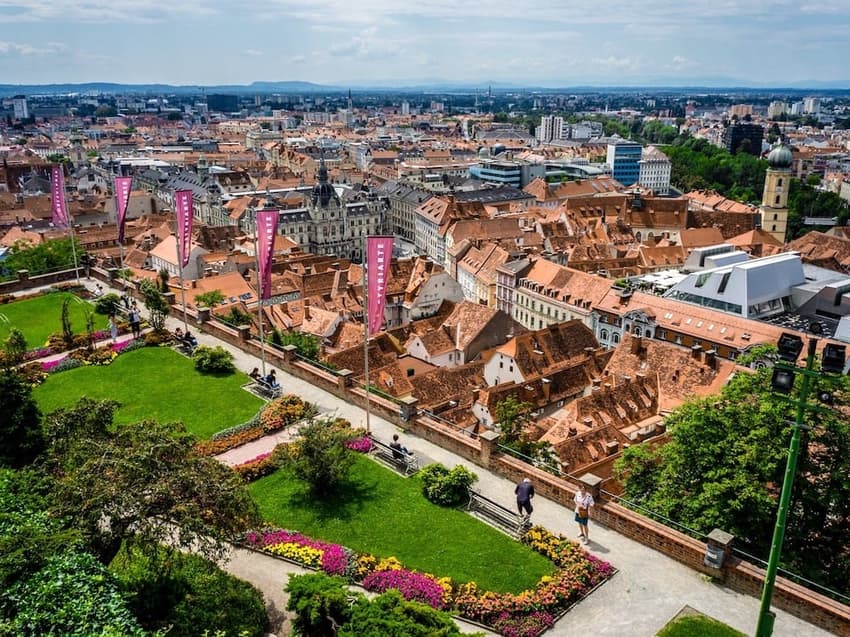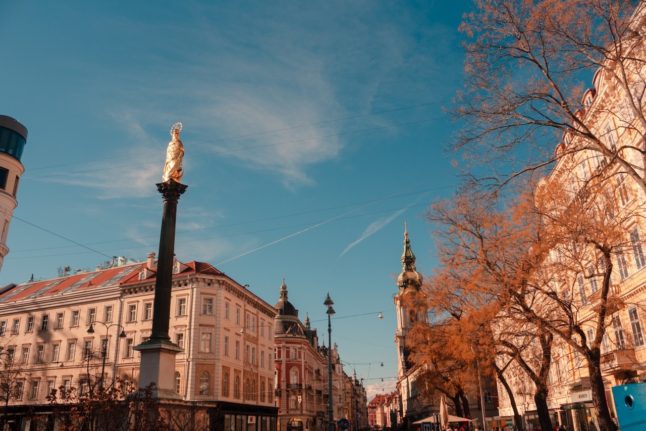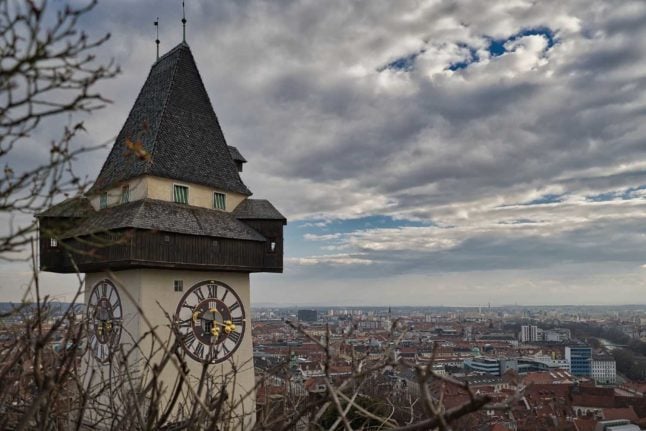Discover Austria: How to make the most of 24 hours in Graz

Although not as popular a tourist destination as Vienna or Salzburg, Austria’s second-largest city has a unique charm and plenty to offer to make a 24-hour stay in Graz worthwhile.
In southeast Austria near the Slovenian border, Graz is a former Slavic settlement dating back to the 12th century. Its rich historical and cultural heritage, mixed with its recent resurgence as a design city, makes for a compelling combination, reflected by the bold modern buildings that have cropped up to complement the more traditional Renaissance and Baroque architecture.
This unique blend of styles has earned Graz international recognition: its old town has been a UNESCO World Heritage Site since 1999, and it has held a UNESCO City of Design Title since 2011.
Graz is not just renowned for its architecture: the city is Austria’s officially designated culinary capital, partly because its position between the Styrian alps and the fertile Grazerfeld basin makes it an ideal setting for agricultural production.
If you are planning to visit Graz but only have a short window of time– perhaps an afternoon arrival and an afternoon departure the following day– read on to discover all you can see with The Local’s guide to 24 hours in Graz.
READ ALSO: Vienna vs Graz: Which city is better for foreign residents?

The old town of Graz at sunset (Photo by Imran Hečimović on Unsplash)
Start in the old town
Graz’s historic old town, just east of the Mur River that cuts through the city, offers plenty to explore in the first few hours after your arrival. Start by getting an aerial view of the renowned district by climbing the Schlossberg, a nearby hill home to the remains of a medieval fortress that now serves as a public park.
To get up and down, you can either take on the 260-step, zig-zagging staircase built into the hill face or enjoy a ride on the Schlossberg Funicular or the Schlossberg Lift
Aside from its stunning views of the Graz landscape, Schlossberg’s main attraction is the Uhrturm (clocktower), whose white facade, wooden balconies, and striking clock face endear it to locals and tourists alike. In fact, Graz residents valued the Uhrturm so much that they paid the French a sizable ransom not to destroy it during the Napoleonic wars in the early 1800s.
Once you’ve made your way back down, you can start exploring the old town proper, which has a variety of intriguing sites all within walking distance. For example, if you want to learn more about the region’s military history, you could check out the Styrian Armoury, which holds 32,000 artefacts used in war, making it one of the largest collections of arms in the world.
READ ALSO: Discover Austria: How to make the most of 24 hours in Innsbruck
Meanwhile, the Graz Cathedral and the neighbouring Ferdinand Mausoleum provide excellent examples of the traditional architecture in the city. The cathedral was constructed in 1438 and features a Gothic exterior and Baroque interior. The mausoleum, considered among the most beautiful in Europe, was commissioned by Emperor Ferdinand II in the 17th century. Its design has an evident Italian influence, and you’ll also be able to appreciate the many religious sculptures and paintings inside.
Conclude your sightseeing with a stroll through the Hauptplatz (main square) and up to Sporgasse, an ancient winding road known for its colourful, scenic storefronts. At the top, you can reward yourself with a pastry at the Höfbackerei, which features a stunning carved wood entryway to go along with delicious treats.

Graz's clocktower. Image: Pixabay
Finish the day off at the Univiertel
Speaking of food, you’ll likely be hungry after a day of exploring. Thankfully, Graz’s old town has plenty to offer, including many vegan and vegetarian options. But if you want to venture further afield, consider visiting one of the many Bausatzlokale in Graz’s Univiertel, a bit further east. These restaurants let you choose the ingredients for your dish, whether a pizza or a baked potato.
Given Graz has a student population of 60,000 or so, this area will be bustling in the evening, and you’ll find plenty of bars if you want to cap off your night with a drink.
READ ALSO: One day in Vienna: How to spend 24 hours in the Austrian capital

(Photo by Daniel J. Schwarz on Unsplash)
Spend the next day across the river
On the following morning, check out the western side of the city. As you cross the river, make sure to stop at the Murinsel. An example of the city’s modern flair, this glass, a dome-like structure constructed in 2003, links two pedestrian bridges which span the river. Inside is a café where you can enjoy a coffee and a strudel as the river flows beneath you.
On the west bank, just south of the Mur Insel, lies another curious structure that exemplifies the city’s new design identity: Kunsthaus Graz. Also built in 2003, the Kunsthaus’s description-defying design has seen it dubbed the ‘friendly alien.’ Inside, you’ll find an extensive collection of modern art.
Finally, you can walk a few minutes north and wrap up your visit by grabbing a bite to eat at one of Graz’s famous farmers' markets: Bauernmarkt am Lendplatz. Open every day except Sunday, here you can get a taste of the local Styrian produce Graz has to offer, like apples, pumpkins, and ham.
Alternatively, you could walk south for a larger meal at Der Steirer, a well-known spot where you can get a traditional backhendl or choose from their myriad selection of Styrian tapas dishes. They also have a wine shop where you can taste the local varieties.
With that, your action-packed 24-hour stay in Graz should be complete. Viel Spaß!
READ ALSO: What you need to know before travelling to Austria in spring 2023
Did we miss your favourite spot or do you have an insider tip you want to share? Leave us a comment below or email us at [email protected].
Comments
See Also
In southeast Austria near the Slovenian border, Graz is a former Slavic settlement dating back to the 12th century. Its rich historical and cultural heritage, mixed with its recent resurgence as a design city, makes for a compelling combination, reflected by the bold modern buildings that have cropped up to complement the more traditional Renaissance and Baroque architecture.
This unique blend of styles has earned Graz international recognition: its old town has been a UNESCO World Heritage Site since 1999, and it has held a UNESCO City of Design Title since 2011.
Graz is not just renowned for its architecture: the city is Austria’s officially designated culinary capital, partly because its position between the Styrian alps and the fertile Grazerfeld basin makes it an ideal setting for agricultural production.
If you are planning to visit Graz but only have a short window of time– perhaps an afternoon arrival and an afternoon departure the following day– read on to discover all you can see with The Local’s guide to 24 hours in Graz.
READ ALSO: Vienna vs Graz: Which city is better for foreign residents?

Start in the old town
Graz’s historic old town, just east of the Mur River that cuts through the city, offers plenty to explore in the first few hours after your arrival. Start by getting an aerial view of the renowned district by climbing the Schlossberg, a nearby hill home to the remains of a medieval fortress that now serves as a public park.
To get up and down, you can either take on the 260-step, zig-zagging staircase built into the hill face or enjoy a ride on the Schlossberg Funicular or the Schlossberg Lift
Aside from its stunning views of the Graz landscape, Schlossberg’s main attraction is the Uhrturm (clocktower), whose white facade, wooden balconies, and striking clock face endear it to locals and tourists alike. In fact, Graz residents valued the Uhrturm so much that they paid the French a sizable ransom not to destroy it during the Napoleonic wars in the early 1800s.
Once you’ve made your way back down, you can start exploring the old town proper, which has a variety of intriguing sites all within walking distance. For example, if you want to learn more about the region’s military history, you could check out the Styrian Armoury, which holds 32,000 artefacts used in war, making it one of the largest collections of arms in the world.
READ ALSO: Discover Austria: How to make the most of 24 hours in Innsbruck
Meanwhile, the Graz Cathedral and the neighbouring Ferdinand Mausoleum provide excellent examples of the traditional architecture in the city. The cathedral was constructed in 1438 and features a Gothic exterior and Baroque interior. The mausoleum, considered among the most beautiful in Europe, was commissioned by Emperor Ferdinand II in the 17th century. Its design has an evident Italian influence, and you’ll also be able to appreciate the many religious sculptures and paintings inside.
Conclude your sightseeing with a stroll through the Hauptplatz (main square) and up to Sporgasse, an ancient winding road known for its colourful, scenic storefronts. At the top, you can reward yourself with a pastry at the Höfbackerei, which features a stunning carved wood entryway to go along with delicious treats.

Finish the day off at the Univiertel
Speaking of food, you’ll likely be hungry after a day of exploring. Thankfully, Graz’s old town has plenty to offer, including many vegan and vegetarian options. But if you want to venture further afield, consider visiting one of the many Bausatzlokale in Graz’s Univiertel, a bit further east. These restaurants let you choose the ingredients for your dish, whether a pizza or a baked potato.
Given Graz has a student population of 60,000 or so, this area will be bustling in the evening, and you’ll find plenty of bars if you want to cap off your night with a drink.
READ ALSO: One day in Vienna: How to spend 24 hours in the Austrian capital

Spend the next day across the river
On the following morning, check out the western side of the city. As you cross the river, make sure to stop at the Murinsel. An example of the city’s modern flair, this glass, a dome-like structure constructed in 2003, links two pedestrian bridges which span the river. Inside is a café where you can enjoy a coffee and a strudel as the river flows beneath you.
On the west bank, just south of the Mur Insel, lies another curious structure that exemplifies the city’s new design identity: Kunsthaus Graz. Also built in 2003, the Kunsthaus’s description-defying design has seen it dubbed the ‘friendly alien.’ Inside, you’ll find an extensive collection of modern art.
Finally, you can walk a few minutes north and wrap up your visit by grabbing a bite to eat at one of Graz’s famous farmers' markets: Bauernmarkt am Lendplatz. Open every day except Sunday, here you can get a taste of the local Styrian produce Graz has to offer, like apples, pumpkins, and ham.
Alternatively, you could walk south for a larger meal at Der Steirer, a well-known spot where you can get a traditional backhendl or choose from their myriad selection of Styrian tapas dishes. They also have a wine shop where you can taste the local varieties.
With that, your action-packed 24-hour stay in Graz should be complete. Viel Spaß!
READ ALSO: What you need to know before travelling to Austria in spring 2023
Did we miss your favourite spot or do you have an insider tip you want to share? Leave us a comment below or email us at [email protected].
Join the conversation in our comments section below. Share your own views and experience and if you have a question or suggestion for our journalists then email us at [email protected].
Please keep comments civil, constructive and on topic – and make sure to read our terms of use before getting involved.
Please log in here to leave a comment.